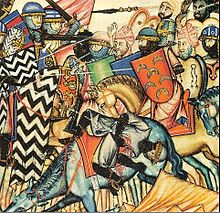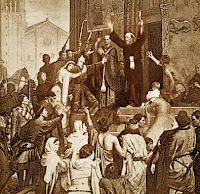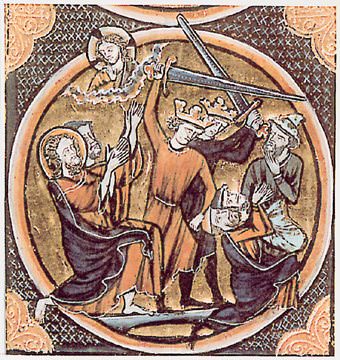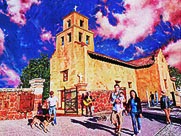 |
| Council of Clermont |
Many sources today claim the destruction of the Church of the Holy Sepulchre to be the spark that ignited the fire known today as the Crusades. This conjecture is somewhat of a stretch. Destruction of the Church of the Holy Sepulchre had occurred in 1009. That’s a full 87 years before the outset of the First Crusade and another 48 years after the completion of the shrine’s reconstruction and re-sanctification. In short, long before the Pope Urban’s declaration of war at the Council of Clermont, this most sacred of Christian shrines had been restored with Christians (Byzantine and European pilgrims) worshiping within, under Muslim protection.
 |
| Emperor Alexios |
Also, there were supporting influences leading up to Pope Urban’s declarations. War with Islam was not an entirely new concept. The Reconquista of the Iberian Peninsula had been in progress for three hundred years, and had seen considerable success.
 |
| Reconquista of Iberian Peninsula |
The term “Crusade” is an English adaptation of the Spanish term “Cruzada” (and later the Frankish “Croisade”) for taking up the cross, and is derived from the Latin “crux” for “cross”. Long before any papal fostered excursions to the Holy Land, the battle between Europe’s Christians and Islam’s Muslims had begun on the Iberian Peninsula during the Reconquista, or the reconquest of territory then occupied by Muslim forces.
 After the conquest of the Iberian Peninsula at the beginning of the 8th century by Islamic Caliphate known as the “Umayyad”, under Tariq ibn Ziyad, the Reconquista would begin with the Battle of Covadonga around 722 (about 85 years after the death of Muhammad). It would ensue until the Fall of Granada in 1492. An ongoing war across a broad scope of history, it raged more than 780 years. The Reconquista was initiated by the Christian Visigoths under Pelagius and ended under Spanish rule around the time of Columbus’ discovery of the New World, just in time for the Spanish Inquisition (more bloodletting in the name of Christ).
After the conquest of the Iberian Peninsula at the beginning of the 8th century by Islamic Caliphate known as the “Umayyad”, under Tariq ibn Ziyad, the Reconquista would begin with the Battle of Covadonga around 722 (about 85 years after the death of Muhammad). It would ensue until the Fall of Granada in 1492. An ongoing war across a broad scope of history, it raged more than 780 years. The Reconquista was initiated by the Christian Visigoths under Pelagius and ended under Spanish rule around the time of Columbus’ discovery of the New World, just in time for the Spanish Inquisition (more bloodletting in the name of Christ).Many historians today include the Reconquista as part of the Crusades because it too was a “War of the Cross”, a “Cruzada”. However, from Europe’s standpoint, the Reconquista was more of a defensive and restorative engagement, with the objective of driving Muslim occupation forces from Spain. Subsequently, Spain was never involved in Crusades to the Holy Land.
 |
| Paupers' Crusade |
Paupers’ Crusade
The First Crusade (1095-1099) is divided into two parts. The first was the “People’s Crusade” or more accurately entitled the “Paupers’ Crusade”. The Paupers’ Crusade was more of a pilgrimage of rabble rather than a military expedition.The initial number of participants in the Paupers’ Crusade was likely higher than 40,000 and included mostly untrained thugs and the very poor, many of whom brought along their families in search of foreign loot. They were lead by the charismatic monk Peter the Hermit (of Amiens) and the knight Walter Sans Avoir, the lord of Boissy-sans-Avoir.
 |
| Peter the Hermit |
Unlike planned pilgrimages where expense and pre-departure foresight went into sustaining provisions for what would amount to a three-month land journey, Peter the Hermit and his civilian mob would be left with indiscriminate pillaging to survive. The number of professional knights accompanying the excursion was no greater than 50, possibly as few as 20. Clearly, Pope Urban put little stock in the eventual outcome of what amounted to a traveling circus.
 |
| Peter the Hermit and the Mob |
Post Departure
The Paupers’ Crusade finally departed for Jerusalem just after Easter in April of 1096. Walter Sans Avoir and his knights would have an incursion in Belgrade, which resulted in 16 of his knights being stripped naked with their armor hung from the city’s battlements. Arriving about a week later, the large numbers within Peter the Hermit’s excursion would react violently to the hanging armor, perhaps thinking their knights had been killed, and began indiscriminate looting and murder of the townspeople, killing 4,000.Upon arrival in Niš, Serbia, a fight broke out in a marketplace. The local government responded by sending out it entire garrison. Over 10,000 of Peter the Hermit’s followers, about a quarter of their ranks, were slain.
 |
| Crusaders and the Jews |
The First Holocaust
For the Jews that happen to be on the road to Constantinople, the Crusades proved a deadly plague. Although it was not declared Church policy, many, if not most of the Crusaders interpreted their plenary indulgence to kill, what Pope Urban had called “the infidels”, as inclusive of Jews. |
| Massacre in Anatolia |
End of the Road
The still untrained and poorly provisioned mob would finally arrive, under Byzantine escort, at Constantinople in August of that year. Disappointed at what he saw, Emperor Alexios would (wisely) not permit the Paupers’ Crusade entry to the city. Instead he had the remaining 30,000 ferried across the Bosporus Strait to Anatolia where they could forage the countryside and wait for the army of armed crusaders.However, the armed excursion was still a few months off and Peter’s band of 30,000 managed to engage the Seljuqs and was massacred. Less than 3,000 escaped death or slavery. No record remains to account for the return of any survivors to Europe. Walter Sans Avoir and his knights were slaughtered as well, Walter's body was reported to have been seen with seven arrow wounds. Convenient for Peter the Hermit, he remained in Constantinople while the unfortunate events across the Strait unfolded. He would then be available to accompany the armed knights upon their arrival.
 |
| Crusaders Crossing the Bosporus Strait |
For Emperor Alexios, the surprise and disappointment at the arrival of Peter and company must have been considerable. Even if he had wanted to, there was no way he could provision and train some 30,000 of the remaining European pilgrims (many of whom were families with children). He was also mindful of possible riots, even a coupe, should he allow them within Constantinople’s formidable gates. Ferrying them across the Bosporus Strait to Anatolia, while they waited for the arrival of the armies that were to follow, was likely his only choice. If Peter’s troop had stuck to the coast, which they did not, they may have been safe.
 There can be no doubt that Pope Urban II had wanted to clean the streets of Europe with the Paupers’ Crusade. With his ongoing religious/political entanglements with Emperor Henry IV in the aftermath of the Investiture Controversy, Europe’s food shortages and the upsurge in crime within all classes, a sudden drop in population would have been a boon for everyone. The exit of the Paupers’ Crusade would, to a limited extent, provide a similar, positive outcome as the “Black Death” plague a few centuries later. Fewer people would improve housing availability while reducing rents. There would also be more job opportunities at better wages for the remaining few. Ironically, Pope Urban would have the Seljuq Muslims to thank for a solution.
There can be no doubt that Pope Urban II had wanted to clean the streets of Europe with the Paupers’ Crusade. With his ongoing religious/political entanglements with Emperor Henry IV in the aftermath of the Investiture Controversy, Europe’s food shortages and the upsurge in crime within all classes, a sudden drop in population would have been a boon for everyone. The exit of the Paupers’ Crusade would, to a limited extent, provide a similar, positive outcome as the “Black Death” plague a few centuries later. Fewer people would improve housing availability while reducing rents. There would also be more job opportunities at better wages for the remaining few. Ironically, Pope Urban would have the Seljuq Muslims to thank for a solution.That the Paupers’ Crusade even arrived at Constantinople now seems somewhat miraculous. However, it’s extremely doubtful the pope ever imagined his traveling circus would be massacred and probably even hoped (prayed?) they would be trained and eventually reestablish some Christian bond with the East. Besides, if they didn’t survive, they always had those plenary indulgences to skip hell and go right to heaven, no matter how much blood was on their hands.
Beatification
After all this, Pope Leo XIII saw fit to beatify Pope Urban II in 1881. His feast day is today celebrated on July 29, ironically, a day that would become Mussolini’s birthday.Click here for 15) The Knights' Crusade
Got Feedback?
Comments? Questions? Corrections? Any feedback at all? Just click on the comments box at the bottom of this page and enter your thoughts. All comments are welcome.
Santuario de Guadalupe, the oil painting by Tom Mallon. This 42" x 22" canvas is the latest addition to the Santa Fe Portrait Series. The Santuario is the oldest shrine to Our Lady of Guadalupe in the US.
Visit this later update by CLICKING HERE
Shostakovich and Cultural Snobbery, Could anyone survive Stalin's Purges, compose a large body, write for himself and the masses while producing constantly great work?
Visit this later update by CLICKING HERE
Tom Mallon's website "MallonArt". This website will provide you with links to all his paintings, drawings and other artwork portfolios, including the ongoing series entitled the Santa Fe Portrait.
Visit this later update by CLICKING HERE




No comments:
Post a Comment